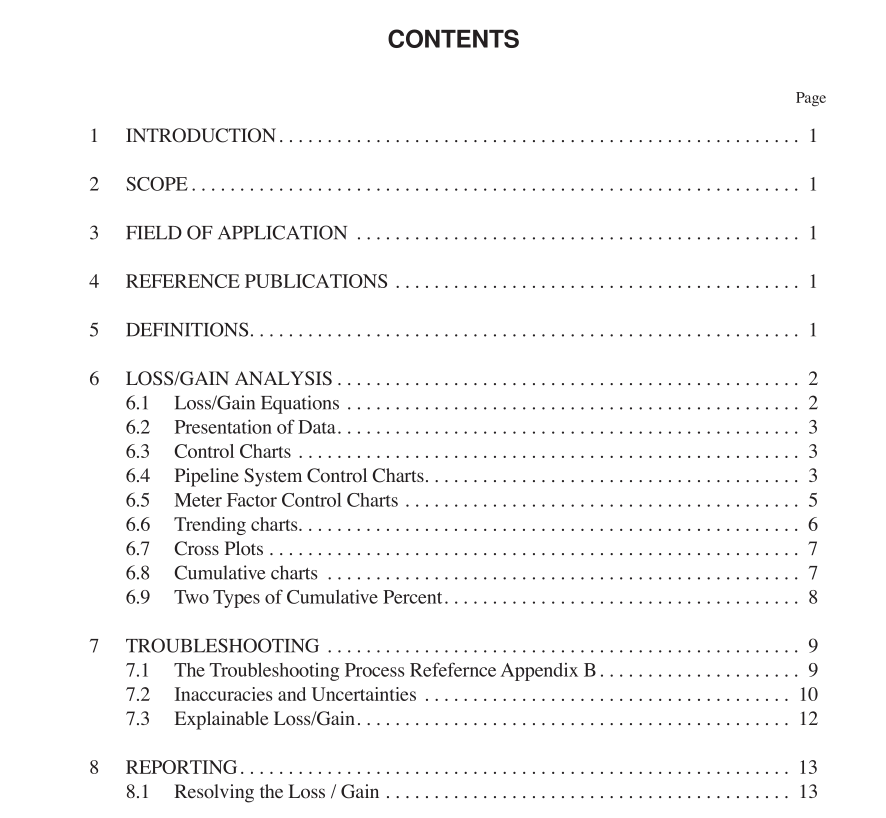API St 2560 pdf download

API St 2560 pdf download.Reconciliation of Liquid Pipeline Quantities
1 Introduction
1.1 In the ideal world every drop of liquid received into a pipeline system and every drop delivered out of the system, as well as all liquid inventory within the system, would be mea- sured and accounted for precisely, and a comparison of all receipts and all deliveriesÑadjusted for inventory changesÑ would be exactly the same. The system would never experi- ence a loss or a gain. Unfortunately, this ideal pipeline bal- ance seldom exists in the real world. 1.2 Most pipeline systems typically experience some degree of loss or gain over time. This represents the normal loss/gain performance for a system. From time to time, losses or gains greater than normal may occur for a variety of rea- sons. Excessive or unexplained loss/gain often leads to con- tention between participating parties, sometimes requiring monetary settlements to adjust for abnormal loss/gain. In such cases, it is necessary to be able to (1) identify abnormal loss/gain as quickly as possible, (2) determine the magnitude of abnormal loss/gain, and (3) institute corrective actions. 1.3 Sometimes losses or gains are real, and adjustments must be made to correct shipper batches and/or inventories. Most of the time, though, there are no real physical losses or gains. The loss/gain that occurs in day-to-day operation is usually small (a fraction of a percent) and is caused by small imperfections in a number of measurements in a system. 1.4 In a sense, loss/gain is a measure of the ability to mea- sure within a system. Loss/gain should be monitored for any given system at regular intervals to establish what is normal for that system and to identify any abnormal loss/gain so that corrective action can be taken.
2 Scope
2.1 This publication provides methodologies for monitor- ing liquid pipeline loss/gain, and for determining the normal loss/gain level for any given pipeline system. Troubleshooting suggestions are also presented. 2.2 This document does not establish industry standards for loss/gain level because each system is an individual and exhibits its own loss/gain level and/or patterns under normal operating conditions. 2.3 The document provides operational and statistically based tools for identifying when a system has deviated from normal, the magnitude of the deviation, and guidelines for identifying the causes of deviation from normal.
3 Field of Application
3.1 The primary application of this publication is in cus- tody transfer liquid pipeline systems in which there is provi- sion for measuring all liquids that enter the system, exit the system and liquid inventory within the system. The applica- tion is not intended for non-liquid or mixed phase systems. 3.2 The applications and examples in this document are intended primarily for custody transfer pipeline systems, but the principles may be applied to any system which involves the measurement of liquids into and out of the system and possibly inventory of liquids within the system.
5 Definitions
For the purposes of this document these speciÞc deÞnitions apply. 5.1 action limits: Control limits applied to a control chart or log to indicate when action is necessary to inspect or cali- brate equipment and possibly issue a correction ticket. Action limits are normally based on 95 percent to 99 percent conÞ- dence levels for statistical uncertainty analyses of the group of measurements. 5.2 control chart—fixed limit: A control chart whose control limits are based on adopted Þxed values. Historically, Þxed limits have been used to control the limits on meter fac- tor changes. 5.3 control chart—loss/gain: a graphical method for evaluating whether loss/gain and/or meter proving operations are in or out of a Òstate of statistical control.









